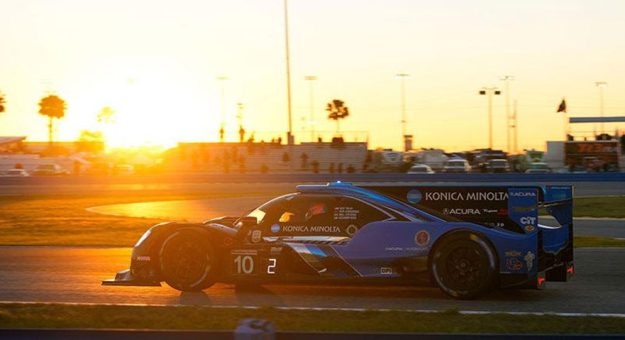DAYTONA BEACH, Fla. — In all sorts of weather, racing day and night, sprints and enduros — the varying conditions are what separate the IMSA WeatherTech SportsCar Championship drivers from most of their racing counterparts.
A twice around-the-clock race at the famed Daytona International Speedway to kick off the year, followed by a 12-hour endurance test on the traditionally tough Sebring International Raceway, a six-hour test at historic Watkins Glen International and then a 10-hour season finale — from high noon to moonlight — at Michelin Raceway Road Atlanta decide the five-class series championships.
It is endurance racing at its best.
And part of what makes the Oct. 1 Motul Petit Le Mans so unique, and ultimately so special, is that the race conditions teams deal with will play such an integral role in deciding the season titles.
“The beauty of Petit is that it is the last race of the year, that also means for many teams, finishing on a high is going to make all the difference going into the winter or the offseason with a good result,’’ said Alex Riberas, driver of the No. 23 Heart of Racing Team Aston Martin Vantage GT3 in the GTD PRO class.
“Some of the teams are out of championship contention and that’s kind of like the perfect recipe for risk-taking. Some will assume a higher degree of risk than they would in a race in the middle of the season. That’s probably one of the reasons I think Petit Le Mans is one of my favorite races in the entire world. It’s always so exciting.”
An important part of the event’s compelling storyline relies on how drivers handle the day-to-night conditions.
The race ranges from potentially bright sunshine when the green flag is scheduled to wave, into the twilight hours, causing treacherous conditions with drivers’ visibility compromised as the sun sets low in the sky. Sunset in Atlanta on Oct. 1 will be at 7:21 p.m., meaning the final two-plus hours of the climactic race will commence in darkness.
Just when so much is on the line — a win in the 25th running of this prestigious race and in many cases a championship trophy — the setting changes. And quite often, what paces a car during the day may not at night.
In some ways, the shift to darkness makes Petit Le Mans feel like two different races.
Interestingly, many drivers say they prefer the night portion of the race, challenges and all.
“The intensity kind of goes up when it’s dark and everything’s feeling good,’’ said driver Ricky Taylor, whose No. 10 Konica Minolta Acura ARX-05 team takes a 19-point Daytona Prototype international (DPi) championship advantage over the No. 60 Meyer-Shank Racing with Curb-Agajanian Acura into the finale.
Taylor says the unique conditions that go with nighttime driving — such as adjusting to other cars’ headlights and the varying speed at which cars from different classes approach or are approached from behind — is absolutely fundamental to a team’s competitive expectations.
“It’s much harder to judge distances when you just see headlights,’’ Taylor explained. “Even when you’re racing another prototype, you have to consider the GT cars as well and how you take risks with them, knowing they might not have the same judgment as they do in the daytime.”
Riberas agreed with Taylor’s assessment of the competitive transition.
“Part of what makes it so challenging is the fact there are so many different classes that are racing at the same time on the same racetrack,’’ said Riberas. With co-driver Ross Gunn, Riberas sits fourth in the GTD PRO standings with wins this year at Long Beach and Watkins Glen.
“During the day, it’s very easy to see if there’s a prototype coming behind you or if it’s another competitor you are fighting for position. At night, everything gets sort of blurry, and it makes for very exciting racing, especially at Petit.
“Some tracks, for example at Daytona, are extremely well lit up,’’ Riberas continued. “But Petit Le Mans, that race is exceptionally challenging. One, because when it gets dark is exactly when you are fighting for the win. That last hour is the most important time of the race. That’s when you are going to fight for the glory basically.
“And there’s some areas on the track where you basically have to rely 100 percent on your memory, on your instincts, to drive the proper line because you don’t really see anything. It’s really that dark.”
More often than not, Motul Petit Le Mans is decided in those final nighttime hours, making not just a driver’s ability to negotiate the dark track essential, but also the driver’s attitude in doing so. And unlike Daytona, Sebring and even Watkins Glen, the elevation changes at Michelin Raceway create a new set of challenges.
“Last year we were able to go through the same situation where the championship was on the line and it was a case of whoever finishes ahead wins the championship,’’ Taylor recalled.
“The nerves may not go up and down dramatically from beginning to end of the race, but they definitely change (at night) in how you approach what you’re nervous about. Once you get to the end of the race, your nerves kind of switch to battling and trying to have a perfect out lap (following a pit stop) and getting through traffic and weighing your risks much more heavily,’’ he continued. “It’s a lot of nerves at the end, but I can’t say you’re any less nervous at the beginning.
“It’s a long day.”
